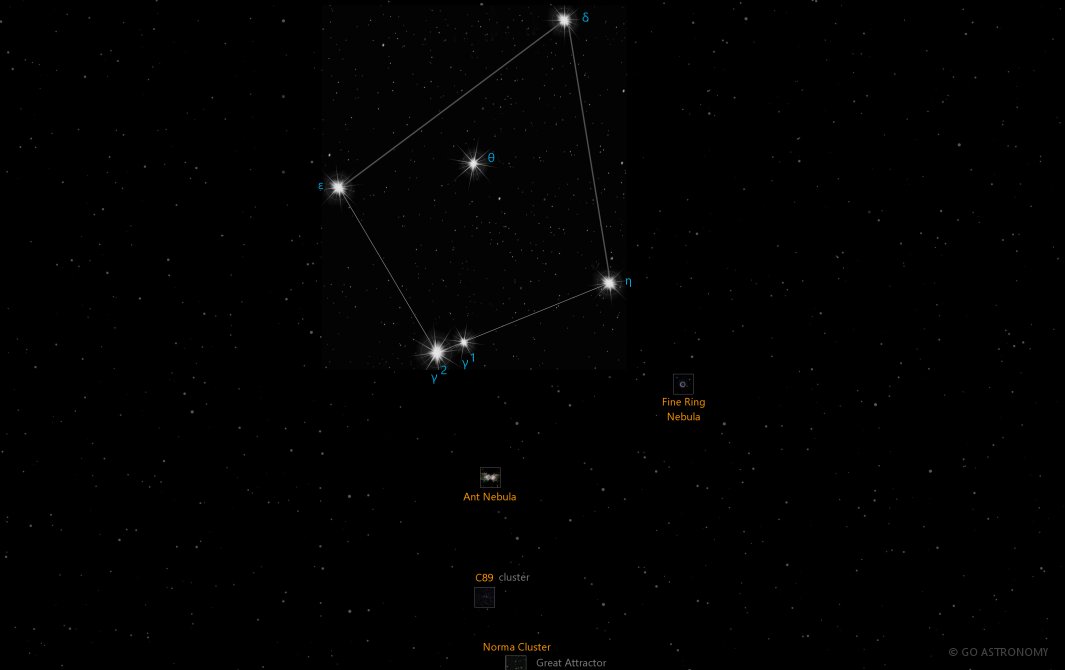Norma, the Square (and Rule) (Nor)
(NOR-muh)
The Southern constellation of Norma, the Square (and Rule), is best viewed in Summer during the month of July.
Norma is the 74th largest constellation. It's brightest star is Gamma2 Normae at magnitude 4.01. The boundary of the Norma constellation contains 4 stars that host known exoplanets.
Red supergiant HD 143183 is the 4th largest known star in the universe at 1,500 times the size of the Sun.
- Pronunciation:
- NOR-muh
- Meaning:
- Square (and Rule)
- Genitive:
- Normae
- Abbreviation:
- Nor
- Constellation Family:
- LaCaille
- Hemisphere:
- Southern
- Quadrant:
- SQ3
- Visibility:
- 30° N - 90° S
- Best viewing month*:
- July
- Area:
- 165 sq. degrees
- Size:
- 74th largest
- Right Ascension (avg):
- 16h 3m
- Declination (avg):
- -52°
- Brightest star:
- Gamma2 Normae (4.01)
- Stars with planets:
- 4
- X-ray stars:
- 9 (3 binaries) stars
- Messier objects:
- |
Brightest Stars in Norma
The 10 brightest stars in the constellation Norma by magnitude.
- Star
- Magnitude
- Spectral class
- Gamma Normae (γ2 Nor)
- 4.01
- G8III
- Epsilon Normae (ε Nor)
- 4.46
- B4V
- Iota Normae (ι Nor)
- 4.63
- A7IV
- Eta Normae (η Nor)
- 4.65
- G8III
- Delta Normae (δ Nor)
- 4.73
- Am
- Mu Normae (μ Nor)
- 4.91
- B0Ia
- Kappa Normae (κ Nor)
- 4.95
- G4III
- Gamma Normae (γ1 Nor)
- 4.97
- F9Ia
- Theta Normae (θ Nor)
- 5.13
- B8V
- HD 147152
- 5.32
- B6IV
Star Clusters in Norma
The most notable and easy-to-find star clusters in the constellation Norma . Also see all star clusters.
- Star cluster
- Catalog #
- Cluster type
- ESO 224-8
- globular
- NGC 5946
- globular
- NGC 6031
- open
- NGC 6087
- open
- S Norma Cluster
- C89
- open
Nebulae in Norma
Notable and easy-to-find nebulae in the constellation Norma. Also see all nebulae.
Galaxies in Norma
The most notable galaxies in the constellation Norma. Also see all galaxies.
Neutron Stars in Norma
These are the most well-known neutron stars in the constellation Norma. Although neutron stars cannot be seen in any amateur telescope, they are at the center of many supernova remnant nebulae, which can be seen. Also see all neutron stars.
Black Holes in Norma
These are the most well-known smaller (non-supermassive) black holes in the constellation Norma. Although black holes cannot be seen directly, the smaller ones are at the center of some star clusters and supernova remnant nebulae, which can be seen. Supermassive black holes are at the center of most galaxies, such as Sagittarius A* at the center of our Milky Way galaxy. Also see all black holes.
- Black hole
- Type
- V381 Nor
- stellar
The Ruler of the Southern Skies
Norma is a small and faint constellation located in the Southern Hemisphere, Latin for "the normal", referring to a right angle or a carpenter's square. Despite its lesser-known status, it serves as a host to a significant amount of interesting astronomical phenomena and has a distinctive historical origin.
Historical Overview
The constellation of Norma was introduced by French astronomer Nicolas Louis de Lacaille in the mid-18th century during his observations of the southern skies. Lacaille named it 'l?Equerre et la Regle', which translates to "the square and rule", in honor of the tools used by carpenters and masons. Later, English astronomer John Herschel suggested shortening the name to Norma, and the name has stuck ever since.
Location and Main Features
Norma lies in the third quadrant of the southern hemisphere (SQ3) and can be seen at latitudes between +30? and -90?. Surrounded by the constellations Ara, Lupus, Scorpius, and Triangulum Australe, it covers an area of 165 square degrees, making it the 74th largest constellation in the night sky.
Main Stars in Norma
Norma does not have any alpha or beta stars due to its faintness and is comprised mostly of fourth and fifth magnitude stars. Gamma Normae, an orange giant with a magnitude of 4.0, is one of the brightest stars in this constellation. Epsilon Normae, another noteworthy star, is a multiple star system consisting of three B-type stars.
Norma also has several interesting variable stars, such as R Normae, a long-period variable star, and T Normae, a cataclysmic variable star system that has experienced notable outbursts.
Deep Sky Objects
Norma is home to several fascinating deep-sky objects. The most notable of these is the Norma Cluster (Abell 3627), one of the most massive galaxy clusters known and an essential component of the Great Attractor, a gravitational anomaly in intergalactic space affecting the motion of galaxies over a region hundreds of millions of light-years across.
Another notable object is the Fine-Ring Nebula (Shapley 1), a planetary nebula that gets its name from the delicate, circular ring of glowing gas surrounding the dying star at its center. There are also several other open clusters and galaxies in this constellation that offer spectacular views for deep sky observers.
Observation
Because of its location in the southern skies, Norma is best viewed from the Southern Hemisphere, becoming visible in early summer and throughout the fall. The constellation's highest point in the sky, or culmination, happens at around midnight in the month of June. Although it doesn't contain particularly bright stars, its position near the larger and more identifiable constellation Scorpius helps to pinpoint its location in the night sky.
* Constellation shown for northen hemisphere skies. For the southern hemisphere, constellations appear rotated 180 degrees (upside-down and left-right reversed) from what is shown. Remember that seasons are reversed too - summer in northern latitudes is winter in southern latitudes.
** Circumpolar constellations are visible year-round in the hemisphere listed (and not at all in the opposite hemisphere).





